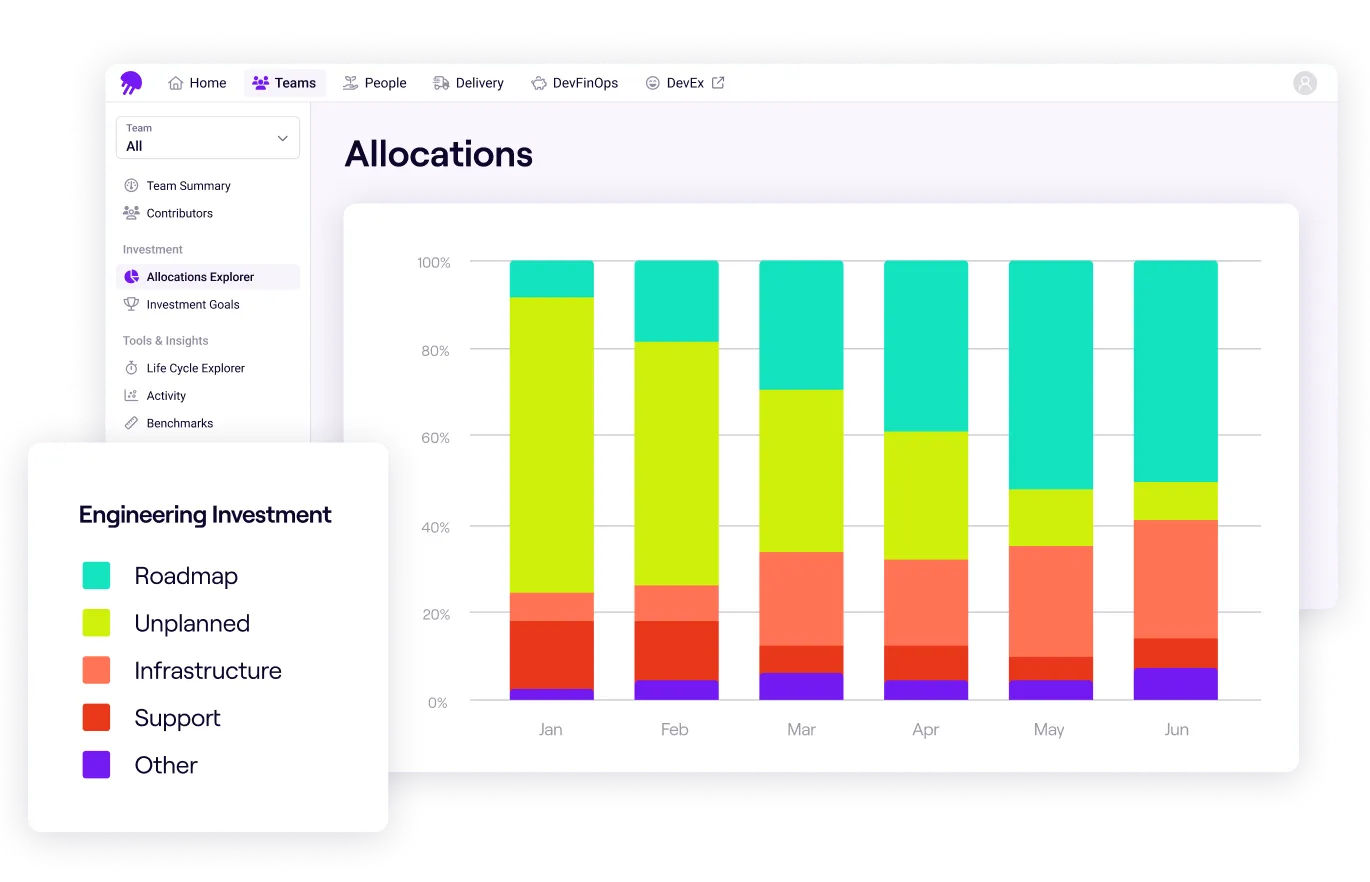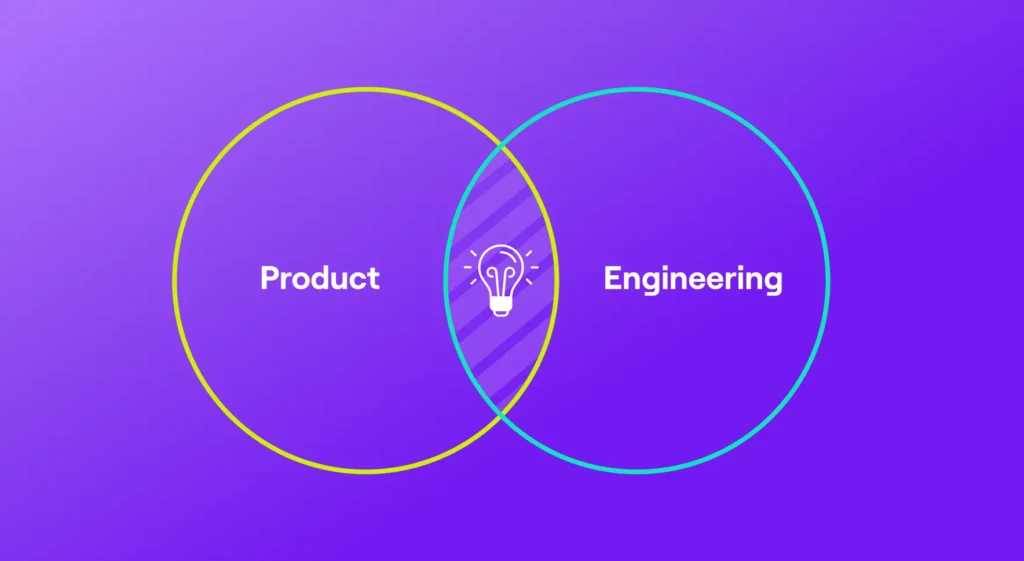Move over velocity, there’s a new metric in town. Today’s engineering leaders have tons of data at their fingertips and hundreds of metrics that they can track. One of the most common questions we hear technical leaders ask is, which ones actually matter? At Jellyfish, we believe that Allocation should be the first metric that modern engineering leaders measure. This metric, in combination with the other metrics we recommend tracking, can help engineering leaders gain valuable insight into their team’s work.
What is Allocation?
What is Allocation?
Allocation is the measurement of the distribution of a software engineering team’s work across a number of axes. In order to inform decisions around investing in new products or capabilities, this metric helps leaders understand how their team’s energy is distributed, and how much capacity they have to take on new projects. Allocation demonstrates to engineering leaders through visualizations how close their engineering teams are ideal to an ideal work alignment. This is done by breaking down the work they do across axes that matter to the engineering organization.
When deciding on what strategic initiatives to measure, many teams will track how much work is going into developing new features vs. managing infrastructure vs. fixing bugs vs. customer support issues, etc. This is a common example of measuring the allocation of engineering investment priorities, but there are many other possible allocation frameworks. Some common frameworks used today include priority projects, product themes, key releases, business objectives, or market segments. All of these frameworks inform your product and engineering strategies to manage down the amount of time on these categories. They also can help manage the expectations of how much new feature work can feasibly be done with the current team.
Allocation is measured in full-time engineers/employees (FTEs). FTEs are tracked by mapping time spent on specific work for each employee to the assigned initiatives. Organizations need to aggregate the total time of the tasks assigned to strategic priorities across all engineers to measure Allocation effectively. Allocation is not widely tracked by most software engineering organizations today because measuring the work done by engineers without adopting an Engineering Management Platform (EMP) is both an error-prone and labor-intensive process.

Example of how the Jellyfish Engineering Management Platform visualizes Allocation
Why is Allocation important for engineering leaders to measure?
Why is Allocation important for engineering leaders to measure?
Measuring allocation provides engineering and business leaders with a clear picture of what your engineering teams are working on in terms of strategic priorities. With Allocation, you can quantify how resources are aligned to strategic priorities. This metric provides a solid foundation for all the other decisions that you have to make as an engineering leader. The common metaphor is that there’s no sense in making rowers row faster if they’re not all rowing in the right direction. Allocation is the way engineering leaders can ensure that the right resources are staffed on the right projects, that the organization as a whole is investing in the types of work, the projects, or the products that will have the greatest impact on the business.
Allocation helps leaders make decisions based on data and insights previously unavailable to them. For example, the 2020 Engineering Management and Alignment Report revealed that engineering leaders overestimate the amount of work allocated to roadmap by 62%. This type of insight is now available to engineering leaders only because of the ability to measure allocation with an EMP. This metric combined with other important KPIs (see our KPIs blog series) helps engineering leaders make strategic decisions based on data. Additionally, it can be an impactful metric to communicate to executive teams because it does not require translating concepts specific to software engineering to other areas of the business.
Why measure Allocation in FTEs?
FTEs is a common unit of measurement understood by other areas of the business, unlike cycle time, number of issues resolved, or story points. By measuring allocations with FTEs, you remove inconsistencies of other units of measure such as story points or number of issues. Story points lack a standard applied approach across different engineering teams. While story points are a tool for engineers and teams to help estimate, plan, and communicate amongst themselves, they tend to be a “best guess,” and to systematically underestimate time spent on less complicated or less important work. And while a vastly different unit of measure than story points, the volume of issues also leads to inconsistencies due to the number of different ways projects can be broken into issues.
How is Allocation measured?
How is Allocation measured?
Measure Allocation Manually
Prior to the availability of this metric through an Engineering Management Platform, engineering leaders struggled to obtain this information quickly or seamlessly. Those that measure Allocation manually dedicate full-time resources to aggregate metrics in preparation for planning or board meetings. The data is manually aggregated, often in spreadsheets by one or more employees. The data can only be refreshed as quickly as the information can be obtained by the resource.
Additionally, to measure this accurately, the dedicated resources may need to spend significant time with engineers ensuring proper data hygiene. Organizations that have been able to accurately track Allocation manually are diligent about keeping records and tagging the work to the appropriate categories in issue tracking systems such as Jira. Some organizations even have engineers or their managers fill out time cards which is often not received well by teams. These practices must be built into the engineering process so that the person(s) responsible for the data aggregation and visualization can be assured high data quality. Organizations looking to track Allocation for the first time manually often face roadblocks and inaccuracies stemming from integrating this tracking into current workflows.
Automate measurement with an Engineering Management Platform
An EMP analyzes data from the tools your team already uses, without manual inputs or changes to your workflows. It then pulls together, cleans, normalizes, and links data from disparate sources. The EMP algorithms then decide what work signals represent meaningful efforts by engineers. These algorithms associate activity performed in your SCM with heuristic workflow data in Jira and other contextual data to accurately reconstruct the work effort of each team member. The upshot is that this information ends up being more accurate, and can be accessed and pulled much quicker than the manual process without interrupting any of the workflows of software engineers.
With the introduction of EMPs, Allocation is now easily measurable by engineering leaders everywhere. Allocation can (and should be) the foundation for all other strategic decisions that engineering leaders make. This metric, along with the others we at Jellyfish recommend engineering leaders measure, can help engineering leaders make data-driven strategic decisions. For more information about Allocation and the other metrics we recommend measuring, check out our 10 KPIs Technical Leaders Should Know blog series.

Interested in learning more about Jellyfish?
See how Jellyfish helps data-driven engineering teams ship better software faster and focus on what matters most to the business.
Tour the ProductAbout the author

Lauren is Senior Product Marketing Director at Jellyfish where she works closely with the product team to bring software engineering intelligence solutions to market. Prior to Jellyfish, Lauren served as Director of Product Marketing at Pluralsight.





